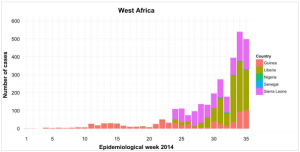 Hosts: Vincent Racaniello, Dickson Despommier, Alan Dove, Rich Condit, and Kathy Spindler
Hosts: Vincent Racaniello, Dickson Despommier, Alan Dove, Rich Condit, and Kathy Spindler
The TWiVers discuss the growing Ebola virus outbreak in West Africa, and an epidemic of respiratory disease in the US caused by enterovirus D68.
Click arrow to play
Download TWiV 302 (82 MB .mp3, 113 min)
Subscribe (free): iTunes, RSS, email
Links for this episode
- Cancer patient saved by measles virus
- Ebola virus genome sequences (Science)
- Robert Garry on Ebola outbreak
- Aerosol transmission
- WHO Ebola outbreak summary
- CDC Ebola outbreak page
- Ebola outbreak epi curve
- CED Ebola outbreak info graphic
- Ebola response roadmap (CDC)
- Ebola outbreak discussion at ICAAC
- Human trial of Ebola virus vaccine (CNN)
- Chimpanzee adenovirus vectored Ebola virus vaccine (Nat Med)
- How US Ebola patients were cured (Sci Amer)
- Ebola outbreak could affect 20,000 (NY Times)
- Ebola infection control resources
- NLM free access to Ebola papers
- Science Ebola papers open access
- Gates donates money for Ebola outbreak (Wash Post)
- Smuggled bushmeat? (Newsweek)
- What we are not afraid to say about Ebola (NY Times)
- Enterovirus D68 outbreak (MMWR)
- Mark Pallansch on EV-D68 (NPR)
- Enterovirus D68 (CDC)
- EV-D68 isolation 1962 (Am J Ep)
- Outbreak of enterovirus 68 (virology blog)
- Letters read on TWiV 302
Weekly Science Picks
Alan – Index to creationist claims
Rich – Wild Kratts
Kathy – Worn away
Dickson – Iceland volcano eruption
Vincent – Immune Quest
Listener Pick of the Week
Kay – Landes Bioscience open access books
Send your virology questions and comments (email or mp3 file) to twiv@microbe.tv


Be a little more precise when you talk about transmissions. Ebola is not transmitted by the “airborne route”. That would be like TB and measles by particles suspended for prolonged periods in air. Aerosol is a bit less precise–when I cough, I can produce an aerosol of what I call the “big chunks” that can land in your eye or on your oral or upper airway mucosa and could cause infection. Airborne requires relatively sophisticated respirators, like PAPRs etc. and sophisticated isolation rooms with negative air pressure and specific flow patterns. See the CDC page on transmission-based precautions. The “big chunks” require contact and droplet precautions, i.e. face shields and surgical nasks, or N95 masks, at most and infection is not by the airborne route. It is an important distinction.
Thank you, Dr. Katz. I’ve been actively dispelling the same mistaken characterizations of “airborne route” on many websites. I don’t know why there is such a popular fixation on “airborne” transmission except for all of the popular mythology about “Zombie apocalypses” etc. Very frustrating to be an infectious disease epidemiologist these days! Best, Charles the DrPH
There is a definition of aerosol transmission; here is Medscape’s:
Aerosol transmission has been defined as person-to-person transmission of pathogens through the air by means of inhalation of infectious particles. Particles up to 100 μm in size are considered inhalable (inspirable). These aerosolized particles are small enough to be inhaled into the oronasopharynx, with the smaller, respirable size ranges (eg, < 10 μm) penetrating deeper into the trachea and lung (Figure).[23,24] Aerosols are emitted not only by "aerosol-generating procedures,"[19] but may also be transmitted whenever an infected person coughs, sneezes, talks, or exhales. Pathogens transmitted by respiratory aerosols can travel short or long range from the source depending on the size and shape of the particles, the initial velocity (eg, cough vs exhalation), and environmental conditions (eg, humidity, airflow).
We do our best to talk about viruses spreading by aerosol. Sometimes we slip up, but we do understand the distinctions.
On the other hand, Michael Osterholm, whose OpEd in the Times we criticized in this episode, talks about 'transmission through the air' when in fact what he means is aerosol transmission.
Ebola virus is not spread between humans by aerosol transmission. Neither does HIV-1. Why these viruses cannot spread by that route is a very interesting question. However, I know of no human virus to acquire aerosol transmission after having spread otherwise (sex, IV drug use, contact with bodily fluids). That is why when MO and the press ask if Ebola virus will 'mutate' to be transmitted by aerosol, we shake our heads.
I was struck by the statement that supportive fluids were vital for helping patients recover from Ebola. The US is currently experiencing a shortage of normal saline which has been going on for months. I worry that if the US can’t manage to produce enough NS for its own current needs, it will be even more difficult to donate it to the Ebola-stricken countries. It’s frustrating how so much of this spread is for lack of very basic supplies: proper PPE and fluids.